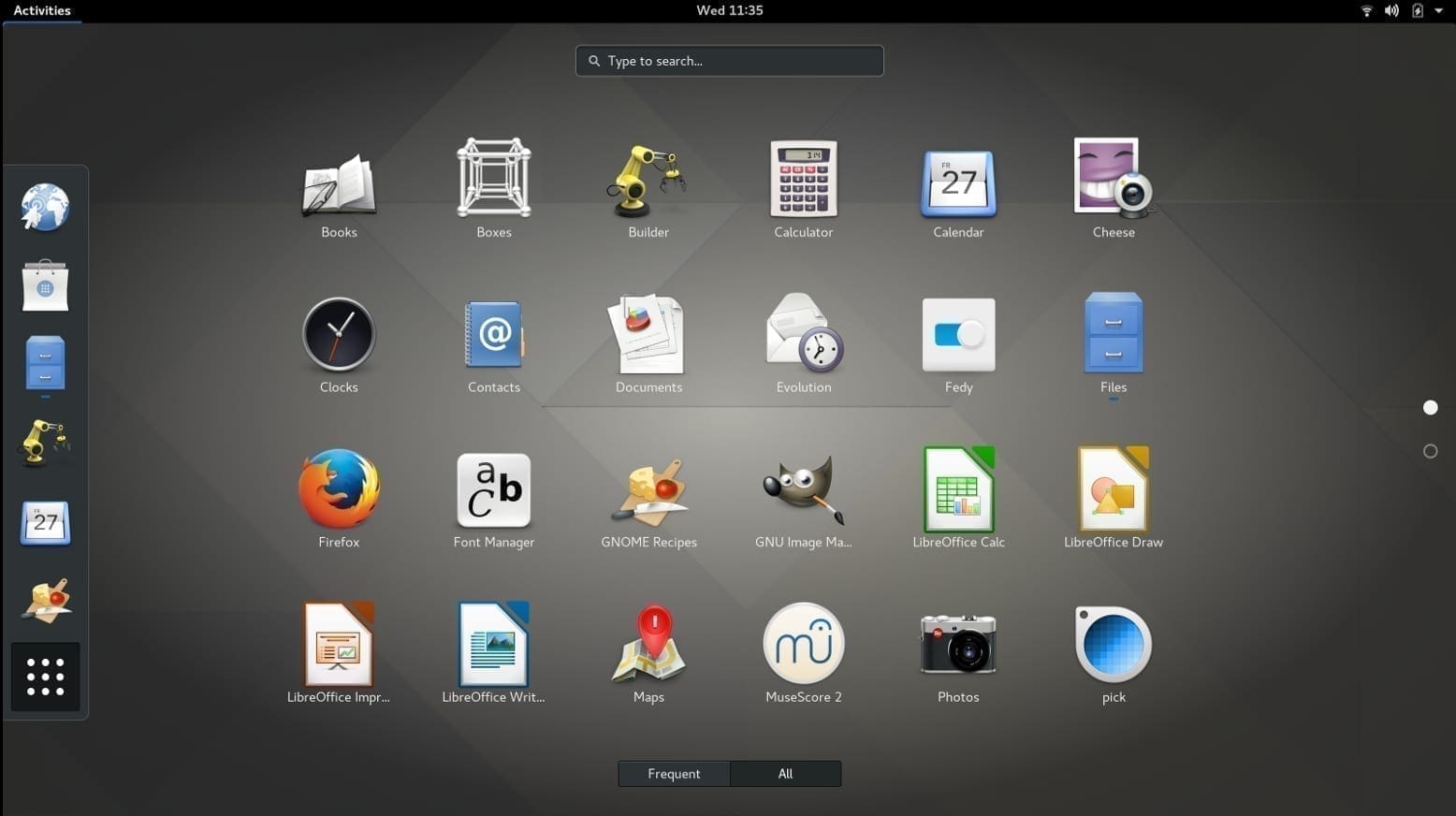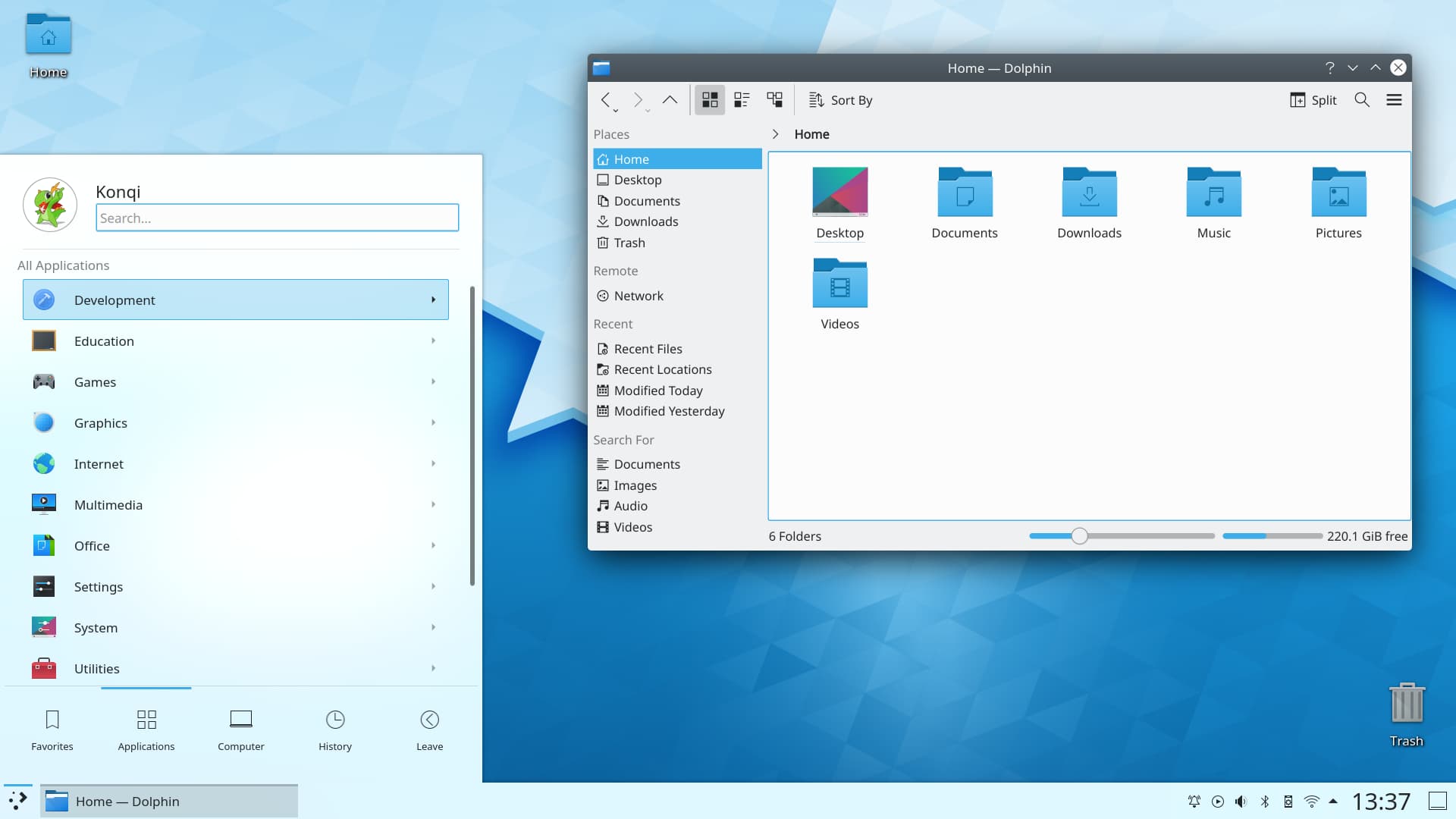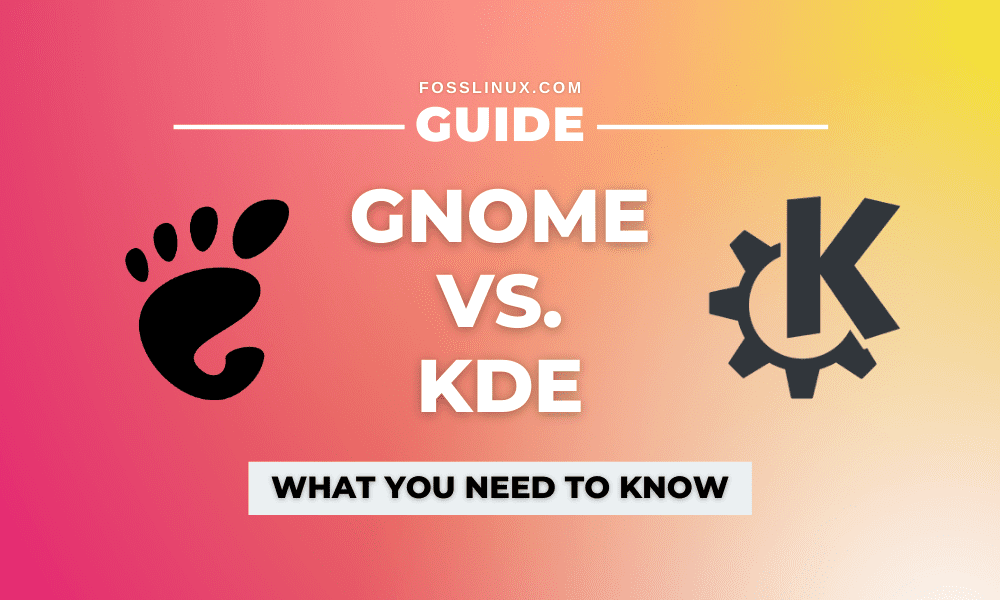The fight for dominance in the Linux desktop environments has mostly been a tug of war between GNOME and KDE. It is difficult to portray a winner in this tug of war. The user community influence and its user preference determine which Linux desktop environment to choose as an adaptive platform. This presumed stalemate in the Linux desktop arena portrays KDE and GNOME as the main major players.
It is common for a Linux user to side with either GNOME or KDE desktop environment based on the Linux community influence, other users’ influence, or usage popularity. This article is here to make an analytical comparison between these two Linux desktop environments. We will explore both the strengths and weaknesses of these two Linux desktop environments. At the end of the article, your decision to go with or remain with either of these two Linux desktop environments will be based on their marketable feature strengths and their evident weaknesses that your Linux lifestyle can accommodate.
GNOME versus KDE comparison
Before we concentrate on this article’s objective, we need to understand and define these two Linux desktop environment candidates comparatively. GNOME, an abbreviation for GNU Network Object Model Environment, is a free and open-source GUI (Graphical User Interface) desktop environment dedicated to run on top of a Linux-based operating system environment.
KDE is an abbreviation for K Desktop Environment and provides a GUI for users to comfortably interact with a Linux-based operating system environment. Its applicability extends to other operating systems like macOS, Microsoft Windows, Solaris, and FreeBSD. It also helps in the GUI design of cross-platform applications supported by these operating systems.
GNOME and KDE are free software, with GNOME categorized under the GNOME project and KDE under the KDE project. GNOME embraces the GTK+ toolkit with GTK apps as its supported products. At the same time, KDE uses the Qt toolkit with its supported products comprising Amarok, KDevelop, Calligra Suite, and KDE Software Compilation.
The design goals of GNOME took a top-to-bottom desktop design approach that mainly focused on ease of localization and internationalization, accessibility, and simplicity. On the other hand, the design goals of KDE took a one-stop desktop environment integration approach. It wanted its desktop users to be comfortable while meeting or achieving their desktop environment usage goals without relying on an Operating System’s command-line interface.
GNOME vs. KDE developmental workflow comparison
The modern development and maintenance approaches of both the KDE and GNOME desktop environments have evolved to make sure that any attempt to differentiate these two desktop environment entities continues to be substantial. This statement would be false in the early days of desktop environment development as both GNOME and KDE were more similar than dissimilar.
The GNOME to GNOME 2 progressive development period portrayed a desktop layout that was similar or familiar to the Microsoft Windows desktop environment release, which existed in that same period. During these early stages and maturity of the GNOME desktop environment, it existed with a launcher that redirected a user to the target OS settings and applications when executed. This early GNOME desktop environment design portrayed simplicity, but it was not enough to ease the OS user navigation experience.
The early KDE desktop environment versions also existed with a simple and adaptable user interface. If we take a closer look at KDE’s past and present desktop environment version designs, the current version is more of a polished earlier version. The GNOME desktop environment’s developmental evolution borrows some aspect of re-inventing the wheel and does not completely concentrate on polishing up the design of its early versions.
This case study is evident with the GNOME 3 desktop environment. GNOME 3 implements the use of a new GNOME shell. It mocks an approach its user community describes as stay out of my way. If we take this description into the GNOME 3 user environment, we get a user experience that allows the Linux OS desktop environment users to easily interact with the OS applications and menus only when there is a need for it.
In simple terms, your Linux desktop environment does not force your user-experience to co-exist with apps you do not need. You have the flexibility of hiding the menu or application launchers that clutter your desktop environment. The desktop environment elements that you do not frequently use will stay hidden and only re-emerge to contribute to a functional user or system objective.

GNOME desktop
As GNOME broke some developmental routines to create its current desktop environment version, KDE preserved its desktop environment developmental steps. It is the reason why we describe its developmental steps as polished. This polish to its desktop environment evolution has attributed it with a modernized user experience feel, which is the perfect substitute to its traditional desktop environment.

KDE Plasma Desktop
GNOME vs. KDE applications support comparison
In terms of handling a Linux desktop environment’s general tasks, both GNOME and KDE portray some shared similarities. That is not to say that the existing design differences are not loudly distinguishable. For example, if we take a look at the KDE applications, the way they deliver their OS functionalities is portrayed to be more robust when compared to the GNOME-based OS applications.
You will also note that the prefix K is included in the naming convention of the OS applications’ names associated with the KDE desktop environment. Under the KDE environment, you are more likely to come across or are already familiar with application software titles like Kmail, Koffice, Kontact, and Kdenlive.
When we look at the GNOME desktop environment regarding this KDE OS application naming or presentation convention, it presents itself as an independent candidate from these convergent OS app naming rules. As an illustrative example, we can list some GNOME-specific apps like GNOME office, Evolution, Pitivi, and various Gtk-based software applications.
When we look at the feature presentation between GNOME and KDE, it is impossible to ignore the KDE desktop environment’s feature-rich nature. A practical and relatable app example is KDE’s PIM (Personal Information Manager). It is a single suite that Kontact bundles other distinguishable or differing software applications.
On the other hand, the GNOME-based Evolution software exists as a single standalone application. Its self-contained nature makes it a personal information manager without the efficiency and prowess of KDE’s Kontact. The Kontact application software has rich functional features like a reputable RSS reader. GNOME-based Evolution app’s extension support is also a feature worth considering in this comparison as Microsoft Exchange servers support it.
If you have had a one-on-one user interactive session with these two applications, Evolution and Kontact, you will be able to clearly find a contrast in the way GNOME and KDE handle OS applications in their environments.
GNOME vs. KDE extended functionality comparison
A software application’s extensiveness relates to how this software app can accommodate other functional implementations to its environment. To this definition, we can attribute both GNOME and KDE desktop environments as functionally extensive.
In GNOME, you can achieve extended functionality through installed extensions. KDE relies on the specificity of Plasmoids as the primary option of achieving extended functionality. The GNOME desktop environment offers the GNOME extension web page’s usage as an easy way to install the OS extensions you might need. The installed extensions can be managed via a GNOME tweak.
Implementing extensions in the KDE desktop environment is somewhat different. The installation of its supported extensions requires that you have some source code-related manual compilations skill set. The KDE Plasmoids facilitate the browsing and installation of the needed add-ons. It is the KDE Add Widgets menu that facilitates the access of these add-ons. Afterward, the Plasmoids download or installation is achievable from your Linux OS local Downloads directory.
We can comment on the add-on’s functionality on these two desktop environment platforms as fairly balanced. The appearance or visual presentation of these two desktop environment’s add-ons is different. Because of the developmental objective behind these add-ons functional design that mandates, they are portrayed as a reflection of the OS environment’s overall flow.
GNOME vs. KDE user type comparison
This comparative section of this article is where most users will decide which of these two Linux-based desktop environments they will switch to or retain their usage. An observation on the usage of the GNOME and KDE desktop environments regarding their respective user communities continues to attract different desktop environment user types. The early launch of these two desktop environments had KDE on the leaderboard with a continuously growing user community support.
This growth curve in user popularity towards KDE and not towards GNOME can be linked with the current developmental milestone of the Ubuntu Linux distribution. Ubuntu has immense support for the use of the GNOME Linux desktop environment as its default desktop feature. Ubuntu was yet to be crowned its deserved limelight during its early development stages as the most popularly used Linux OS distro. It is now understandable why KDE became the go-to primary desktop environment option for the growing number of newbie users that found it user-friendly enough.
Fast forward to the present time setting, and we have GNOME sitting on the throne of Linux desktop environment popularity where KDE used to reside. Most of the current newbies that want to engage and familiarize themselves with the world of Linux operating systems find the GNOME desktop environment as an ideal preference over KDE. The GNOME 3 desktop environment has inspired the development of other desktop environment flavors from its GNOME shell.
It is also responsible for a growing number of desktop environment support. An example of a GNOME 3-inspired desktop environment is the popular Cinnamon desktop environment packaged with Linux Mint. Another user-favored desktop environment that exists because of GNOME’s traditional and present development footprints is the MATE desktop environment.
We should be careful to note that this newcomer or newbie thrill and preference that lets Linux users side with the GNOME desktop environment are mainly because of its association with the Ubuntu Linux distribution’s popularity. Ubuntu has great community support that caters to both newbies and experienced users. A new OS user is most likely to go after an operating system with a traditional appeal other than the one that poses modern tweaks on its desktop environment.
As such, a traditional desktop environment is easily adaptable. Also, the Linux universe is primarily themed as free and open-source. This attribute applies to most Linux distributions and flavors. Because of the free and open-source Linux status, the users centered to other Linux distros or flavors that want to give the KDE desktop environment a try have the option of installing it on their machine. Here are some supportive reasons why the KDE desktop environment will blend well with other Linux distros and flavor users.
GNOME vs. KDE: which one is better and why?
It is time to toss a coin and decide if you are a GNOME-based user or a KDE-based user. To make this choice, you will have to make a performance decision regarding which of these two Linux desktop environments you think is best applicable to your Linux usage circumstances. The key points to note include the simplicity and ease of use of either of these desktop environments.
Some users find certain environments complex, while others will find them easily adaptable. This decision cannot be review-based. Another key point is the control the desktop environment feeds you as its user. Are you controlling the desktop environment, or is the desktop environment controlling your user experience? Finally, you have to consider how easy it is for you to access your user data from the desktop environment’s navigation menus. You should take minimal steps to reach your user-stored data.
Final note
Your desktop environment preference or choice between KDE and GNOME is non-fatal. Choosing one does not leave you vulnerable or exposed to unsatisfying user experiences just because of these desktop environments’ distinguishable features. Developed Linux-based applications are functionally adaptable to both KDE and GNOME desktop environments. Do not worry about the Qt-based apps that favor KDE or the gtk-based apps that favor the GNOME shell environment.
As long as we live in a free and open-source Linux world, no Linux app is too special to reside in a single Linux-based desktop environment. The Linux community support is always finding ways to assign each of its supported apps a global attribute. If we can run some Windows-based apps on a Linux environment, what could be difficult to achieve this same objective when dealing with apps developed for specific Linux distributions or flavors?
Your choice or preference between KDE and GNOME desktop environments should not be about app support but about how easy it is for you to adapt and navigate on either of the Linux-based desktop environments.

